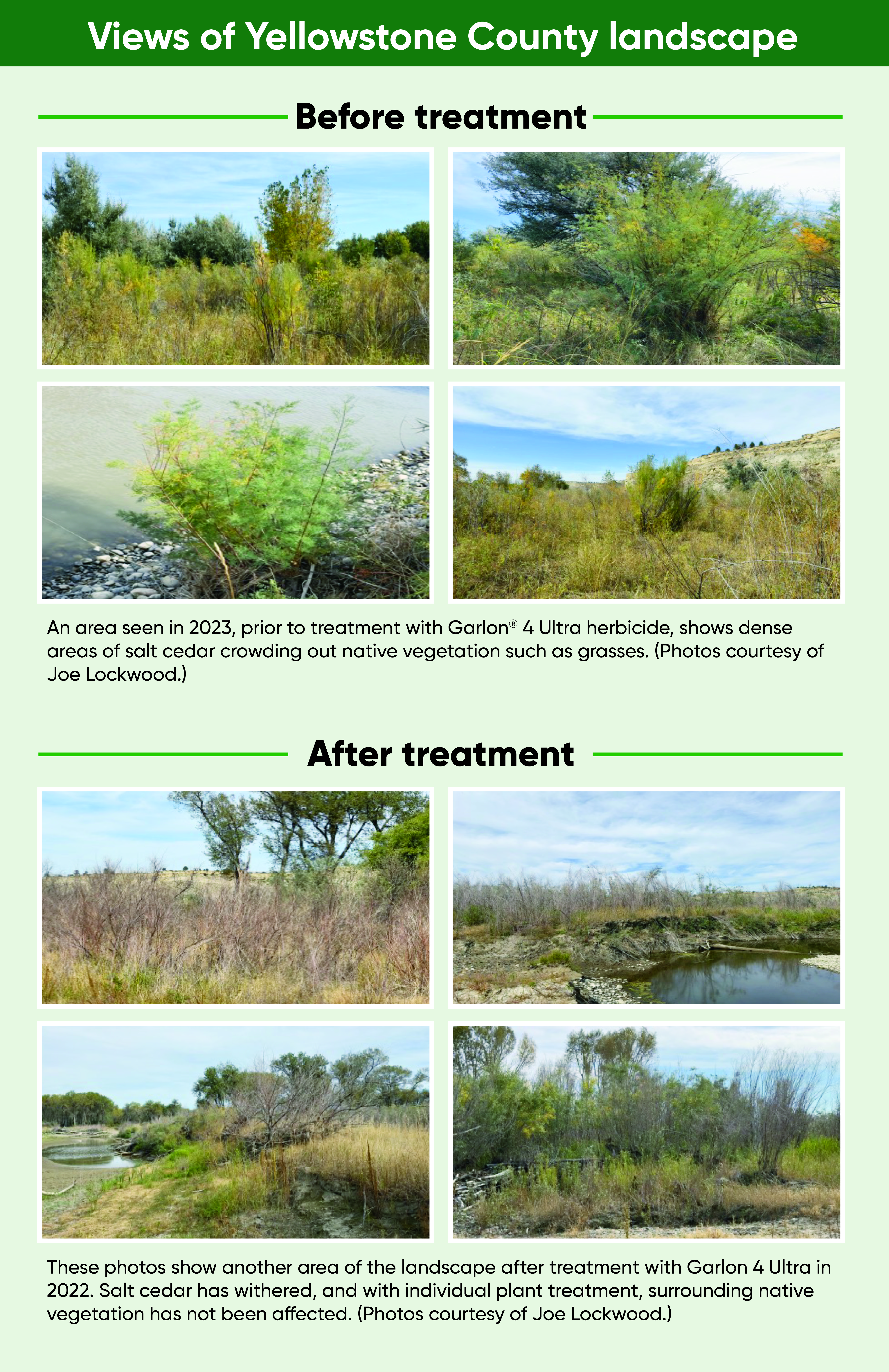Controlling Invasive Salt Cedar

Yellowstone County in south-central Montana is named for the Yellowstone River, the largest undammed river in the lower 48 states. Stretching out from its banks are farms growing corn, alfalfa, safflower, peas and sugar beets; pastures where livestock graze; open ranges where wildlife roam; and some of the most beautiful parts of the country for camping, fishing, hiking and hunting.
This economically and ecologically important landscape is threatened, however, by the presence of invasive salt cedar trees. Described as a “thirsty tree,” one acre of salt cedar can use up the equivalent of 2.8 million gallons of water. Water is a precious resource out West. In Yellowstone County, it’s even more important as some parts of the area receive more rainfall than others. Some cropland is irrigated, and every drop matters.
Salt cedar was introduced as an ornamental landscaping plant in the 1800s and started to become an invasive threat by the 1920s. The tree moves into creeks and riverbanks, where it sucks up the available water supply and secretes salt into the soil. This prevents native vegetation from receiving necessary moisture. Eventually, salt cedar crowds out the native species.
Joe Lockwood is the Yellowstone County Weed Coordinator. The county spans more than 1.7 million acres. Lockwood manages weed control for thousands of miles of rights-of-way including for various types of roads, highways and rail lines. Salt cedar is one of the important species the county has to monitor and control. “I’ve noted over the years as we move eastward on the Yellowstone River that the salt cedar has become denser and has created its own monoculture in areas along the riparian zone,” Lockwood said.
Salt cedar can have multiple effects on the landscape. That’s why in Yellowstone County, they initiated the Yellowstone Salt Cedar Project in 2007 with four important goals.
Salt cedar is hard to control with foliar applications. Salt cedar is becoming increasingly dense in the Yellowstone River region as well. This can make it difficult to treat the unwanted trees without harming native species. Lockwood said salt cedar seedlings are often hidden in tall grass and willows. For these reasons, aerial treatments don’t usually provide adequate control of salt cedar and can have the downside of damaging desirable vegetation. This may leave fewer native plants for animals to graze and can also make the area hospitable to even more invasive plants, creating a vicious cycle.
In Yellowstone County, the salt cedar invasion has been relentless. In 2022, the project treated over a million salt cedar trees. Lockwood said, “The number of salt cedar trees that we are finding in [floodplain] areas is astronomical.” For land managers facing similar infestations, it’s important to have an option that provides reliable control and makes it easier to maintain desirable vegetation.
Since the Yellowstone River Salt Cedar Project began in 2007, the team has been using Garlon® 4 Ultra herbicide (triclopyr) to control salt cedar. Individual plants are treated with a combination of 25% Garlon 4 Ultra and 75% basal bark oil. “Garlon 4 Ultra mixes well with basal bark oil and does a very good job of translocation into the root system of the plant,” Lockwood said. “We treat each individual plant 360 degrees around the stems, and from ground level to 18 inches up on the stems.”
This individual plant treatment approach helps limit collateral damage to the surrounding vegetation, but Lockwood noted that because the plants are so dense and intermingled with native plants, “You cannot totally eliminate collateral damage when treating monocultures of salt cedar.” The project has found, however, when unavoidable collateral damage does occur, native species recover within 1–2 years. Lockwood observed, “It seems like the native species come back even stronger in those areas,” likely thanks to reduced competition from salt cedar.
The project begins its annual control efforts in the fall when salt cedar trees transfer carbohydrates into their root system for the following season. “This helps increase the uptake and translocation into the root system after treatment,” Lockwood said. This makes Garlon 4 Ultra a good choice, because it has a flexible application window and can be used year round.
When the project began, application was done primarily via backpack sprayers from drift boats. Now, most application is done via UTVs. “The current practice we are using works very well and I don’t see changing it in the near future,” Lockwood said.
The images below provide examples of visible results across the county. Lands treated by the project include those owned by small- and large-scale farmers and ranchers as well as by government agencies, such as the BLM.

With the Yellowstone River Salt Cedar Project entering its 18th year, Lockwood has plenty of experience in controlling this difficult invasive. Here are some of his tips:
For the Yellowstone River Salt Cedar Project, the work continues, and that includes showcasing the program’s benefits to secure funding that will allow them to keep up with current treatments and expand as needed. Since the initiation of the salt cedar project, “Landowners have really noticed the control we are getting on salt cedar,” Lockwood said. “They’ve also noted just how invasive salt cedar can be.”
When treating areas in and around roadside or utility rights-of-way that are or will be grazed, hayed or planted to forage, important label precautions apply regarding harvesting hay from treated sites, using manure from animals grazing on treated areas or rotating the treated area to sensitive crops. See the product label for details. State restrictions on the sale and use of Garlon® 4 Ultra apply. Consult the label before purchase or use for full details. Always read and follow label directions.
Sharing innovative research, success stories and tips with invasive plant managers.